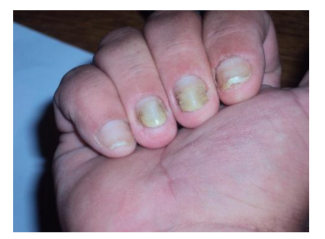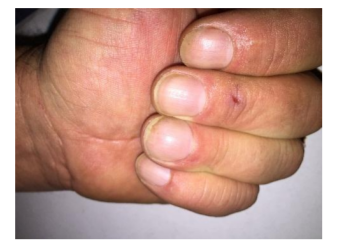Information
Journal Policies
ARC Journal of Clinical Case Reports
Volume-4 Issue-3, 2018, Page No: 17-19
Successful Treatment of Yellow Nail Syndrome with Intravenous Immunoglobulins
Malgorzata Sobieszczanska1, Slawomir Tubek2
1.Department of Pathophysiology, Wroclaw Medical University, Wroclaw, Poland.
2.Department of Internal Diseases, Voivodeship Hopsital, Opole, Poland.
2.Department of Internal Diseases, Voivodeship Hopsital, Opole, Poland.
Citation : Malgorzata Sobieszczanska, Slawomir Tubek, "Successful Treatment of Yellow Nail Syndrome with Intravenous Immunoglobulins" ARC Journal of Clinical Case Reports 2018; 4(3) : 17-19.
Copyright : © 2018 Authors. This is an open-access article distributed under the terms of the Creative Commons Attribution License, which permits unrestricted use, distribution, and reproduction in any medium, provided the original author and source are credited.
Abstract:
yellow nail syndrome, immunoglobulins treatment,Clinical Case Reports
A case of a 50-year old man suffering from yellow nail syndrome (YNS), whose morphological changes of nail plate regressed after intravenous immunoglobulins treatment (IVIG) was presented.
yellow nail syndrome, immunoglobulins treatment,Clinical Case Reports
1. Introduction
Yellow nail syndrome was first described in 1964 by Samman and White [1-3]. This rare syndrome is characterized by dystrophic, over-curved and slow-growing yellow nails, bilateral lymphedema of the legs, and lung abnormalities, including pleural effusion and bronchiectasis (Samman-Emmerson syndrome). Other variable manifestations include recurrent sinusitis, recurrent respiratory tract infections, pericardial effusion and, rarely, ocular abnormalities. Yellow nail syndrome has been associated with autoimmune disorders such as thyroiditis, systemic lupus erythematosus and rheumatoid arthritis. There are also isolated case reports of yellow nail syndrome associated with malignancy. Familial cases have also been reported. Since its first description in 1964, the pathogenesis and genetic basis of this syndrome have not been established [1-3]. One of the hypotheses explaining it is the immunological background of the syndrome. In 1979, 2 out 3 reported cases of YNS had lower level of IgM [2]. In 2003, there was a case of a patient with YNS who had selective antibody deficiency manifested by impaired IgG antibody response to polysaccharide antigens. The patient demonstrated impaired IgG antibody responses following immunization with Pneumovax and an H. influenza B vaccine [4]. In 2005, it was reported that 3 out 5 patients with autoimmunity disorders, who were treated with anti-tumor necrosis factor (anti-TNF) agents (infliximab, etanercept or adalimumab), had side effects in the form of changes in nail plates like in YNS [5]. In 2012, Gupta et all presented the first extensive immunological analysis of both adaptive and innate immunity in two patients with YNS. One patient had common variable immunodeficiency, whereas the second patient had specific antibody deficiency syndrome, severe lymphopaenia, a striking deficiency of naive CD4+ and CD8+ T cells and total B cells. What is more, increased transitional B cells were observed. T cell proliferative response to mitogens and antigens was significantly reduced in both patients. Both patients failed to make specific antibody response to pneumococci. Complement, natural killer cell activity and neutrophil oxidative burst were normal. Immunoglobulin administration resulted in decreased frequency and severity of infections, and an impressive effect was observed on lymphoedema and on the recurrence of pleural effusion. The data show that YNS is associated with both T and B cell defects. „Furthermore, immunoglobulin may be beneficial in clinical manifestations of lymphoedema” [6].
2. Case Report
A 50-year old patient with YNS, ineffectively treated, was admitted to internal diseases department for intravenous immunoglobulins treatment (see picture 1 – prior to the treatment). Patient’s history revealed that he was a lifelong smoker with confirmed allergy to chrom, nickel, cobalt and with suspected allergy to titan. He had been diagnosed and treated for sinusitis for many years and for more than two years he had bilateral lymphoedema of the lower legs and for 4 years he had YNS of both hands and feet. Due to chronic sinusitis, the patient underwent endoscopic mucosal resection (EMR), which resulted in regression of upper airway disorders. However, it proved ineffective in nail changes of YNS. Neither antifungal medication nor attempts to eliminate allergens not improved them. Blood lab tests did not show any abnormalities apart from mixed hyperlipidemia and insufficient glycaemic control. Liver and kindney functions were normal. Thrombocytes were slightly below the norm. The tests did not show immunoglobulin deficiency. IgM (carried out 3 times in a month) represented lower limit of normal, i.e., 0,44 - 0,54 g/l (norm: 0,4 – 2,3 g/l). Complement's parameters was normal. Other exams were also carried out to find YNS-related pathologies. CT scan showed normal chest image without noticeable fluid in pleural cavity or bronchiectasis. Head X-ray reaveled many osteomata. A complete set of endoscopic tests was carried out and found gastroesophageal reflux disease and confirmed chronic gastritis of antral part with Helicobacter pylori infection. Colonoscopy showed small polyp in sigmoid. Histopathology of polyp revealed a low grade adenoma tubulare.
YNS presented a major psychosocial problem to the patient due to estethics and perceived discomfort. This was the reason for recommending immunoglobulins. Between May 2014 and August 2014 the patient received 5 intravenous infusions of 15 g of Octagram (by Octopharma) each time. As predicted, after 6 months almost total recovery was observed; almost all discolouration disappeared, nail plate separated from matrix and separation of nail plate was observed. As a result patient had watch-glassed nails and clearly elongated and lined plates (see Figure. 2).
3. Commentary
Disappearance of YNS after intravenous immunoglobulins treatment, in patient whose previous treatment was ineffective, suggests immunological background of YNS, which the aforementioned literature confirms. In one study, the intravenous immunoglobulins treatment was applied in two cases [6]. In the case, we describe here, the intravenous immunoglobulins treatment resulted in regression of both YNS and bilateral lymphedema of the lower legs. IV-IG acts as an immunomodulator by suppression of antibody production, Fc-receptor blockade and anti-idiotypic reaction [7]. In our case, the all mechanisms could be perceived as favourable effects of IV-IG. Administration of IV-IG in YNS, after ruling out cancerous processes, can be seemed a recommendable method. With regard to the watch-glassed nails effect of the intravenous immunoglobulins treatment, further research could investigate, whether there is a pathogenic correlation between YNS and clubbed fingers.
References
- Avitan-Hersh E, Berger G, Bergman R., Yellow nail syndrome. Isr Med Assoc J. 2011 Sep;13(9):577-8.
- Lubach D, Stolte H. Yellow nail syndrom-- clinical signs and differential diagnosis. Med Klin. 1979 Sep 7;74(36):1291-4.
- Bokszczanin A1, Levinson AI.Coexistent yellow nail syndrome and selective antibody deficiency.Ann Allergy Asthma Immunol. 2003 Nov;91(5):496-500.
- Gupta S1, Samra D, Yel L, Agrawal S.,T and B cell deficiency associated with yellow nail syndrome.Scand J Immunol. 2012 Mar;75(3): 329-35.doi:10.1111/j.1365-3083.2011.02653. x.
- Sfikakis PP1, Iliopoulos A, Elezoglou A, Kittas C, Stratigos A.Psoriasis induced by anti-tumor necrosis factor therapy: a paradoxical adverse reaction.Arthritis Rheum. 2005 Aug;52(8): 2513-8.
- Iheonunekwu N1, Adedayo O, Clare A, Cummings C.Yellow nail syndrome in a medical clinic.West Indian Med J. 2011 Jan;60(1):99-101.
- Dwyer JM. Manipulating the immune system with immune globulin. N Engl J Med. 1992;326:107–16. doi: 10.1056/NEJM1992010 93260206.






